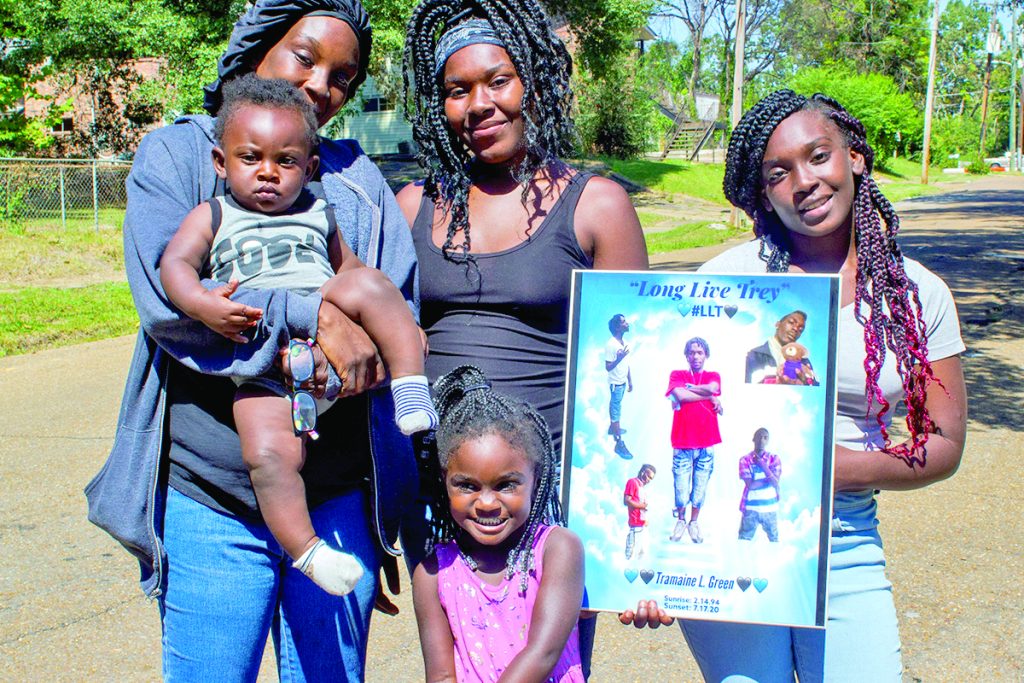Part I
Tramaine Green, 26, stares into the camera, almost as if the person taking the picture snapped the photo at just the right moment.
He’s wearing a red shirt and has earbuds in his ears and a blue towel in his hand. A blue Mustang is parked in the background. The photo hangs in his family’s living room right across from the kitchen. His ashes, in a blue urn with gold embellishments, sits not far from his photo.
“He was a good son. He was sweet. He was respectful to people. He loved to help. He loved his family,” Shaneika Green, Tramaine Green’s mother, told the Mississippi Free Press in her Jackson living room on June 7, 2021. “He had his own ways, but everybody loved him.”
When the pandemic first started in March 2020, Green was just your average working mother. She got up each weekday to go to work at her job at Walmart on Highway 18, not a far commute from where she lives in West Jackson. She was thinking then of going back to school to pursue a career in the medical field, to try to better herself, the 42-year-old said.
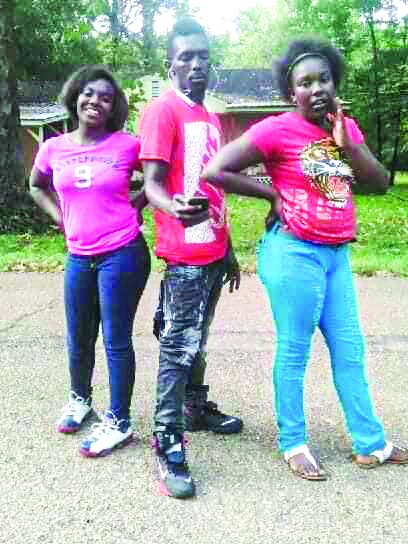
Tramaine Green (middle) with his younger sisters, Shirley (left) and Odella Green (right). He and Shirley share the same birthday month: February. Photo courtesy Shaneika Green
Green and her family were navigating COVID-19 with caution, following guidelines and using the supplies she would bring home from her job. She was happy. Her kids were happy. Everything was good, she said.
As an added bonus, her son, Tramaine, got out of prison after being locked up almost a year for burglary right before July 4 festivities. He came home with an ankle monitor.“The last time we saw him was on the Fourth of July. We talked on the phone, and he said he may stop by, but just spending time with him, Fourth of July was the last time,” the mother said.
‘When My Son Died, My Body Died, Too’

Tramaine Green, 26, was the oldest of six siblings, and his mother describes him as very protective of anyone he cared about. Photo courtesy Shaneika Green
Gun violence killed Tramaine on July 17, 2020, on Belvedere Drive near Fremont Street close to both Peeples Middle School and Key Elementary. Police found his body on the side of the South Jackson road at 4 a.m. riddled with multiple gunshot wounds. He was 26, the oldest of six siblings, and his mother describes him as being like any other kid. He was protective of her and his siblings or anybody he cared about. He was the type of person you’d fall in love with when you first met him, she described.
“I tell everybody I would rather him stay in jail than out, because at least in jail I know he would still be alive,” she said.
“(The ankle monitor) was like a waste of taxpayer’s money. If you weren’t going to make use of it and do what you’re supposed to do with it, what’s the point of putting it on him and letting him out?” Green questioned.
Tramaine Green was one of 128 homicides in Jackson in 2020, continuing a rising trajectory since 2019, which saw 83 homicides. In 2021, there were 154 reported homicides, surpassing 2020’s record.
Violence isn’t just spiking in Jackson, but all over the country. In 2020, crime increased by 25% or more in the U.S., totaling more than 20,000 murders since 1995, preliminary FBI data show. The pandemic was a clear factor, experts say, causing higher unemployment rates, increased poverty and stretched resources in the wake of a global health crisis the likes of which our generations had never experienced.
Following national trends, researchers say Covid-19 has worsened gun violence across the country, with rates rising by 30% during the pandemic. Before the coronavirus, there were 38,919 incidents compared to the more than 50,000 that occurred during the first year of the pandemic. Gun sales also rose from 32% in 2016 to 39% in 2020, with a fifth of the gun owners being first-time buyers, The Guardian reports.
“Recent data support the notion that in some U.S. cities, gun violence (GV) is reaching an all-time high,” a 2021 report by Gun Violence Archive researchers, detailed on Nature.com, showed. “Philadelphia (Pa.) is just one example of this, with 141 shootings in March of 2020, “making it Philadelphia’s worst March for [GV] in five years.”
Four months after her son’s death, Green caught COVID along with her two daughters, one of whom was pregnant during that time. Green said she started suffering from body aches and loss of taste before the Christmas holidays, but she thought it was the flu.
But in January 2021, once her daughter tested positive, she decided to get tested as well, and it came back positive. She believes she got it from someone at her job. “I didn’t go to the doctor,” she said. “My mother just told me to drink Theraflu and a lot of hot fluids to feel better.
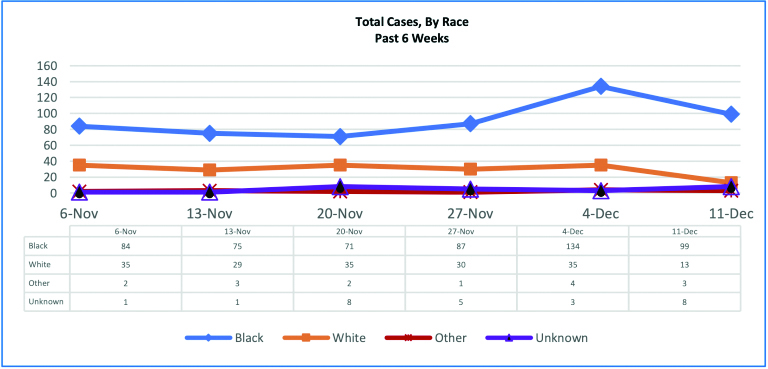
From November 2021 to December 2021, Black people in Mississippi had the highest number of Covid-19 cases of any other race. Graphic by MSDH
Hinds County is very high risk for covid-19 with 211.6 daily new cases per 100,000 people and an infection rate of 1.14, as of January 18. As of January 18, hospitalizations were in the critical stage with 90% of the ICUs being used and an average of 346 COVID-19 patients in hospitals.
The Mississippi State Department of Health reports that, as of Jan. 12, 2022, Covid cases in Hinds County—which is 69.1% Black—totaled 43,895, with 26,500 of those cases Black people. Black women in particular seem to be most vulnerable as they made up 124,007 cases across the state as of Jan. 12, 2022, compared to Black men who were 82,619 of the cases. To date, 1,996 Black women have died from Covid-19 in the state.
Luckily, Green’s job paid her for the two weeks she took off to get better, lifting one burden off her shoulders. But being sick while grappling with the loss of her son was a tough period for her.
“That was my first time ever being sick. It’s like when my son died, my body died, too,” Green said.
‘Voluntary Separation of the Races’
Green and her family previously lived in the vicinity of the Jackson Zoo. Arguably, there is no more dramatic or contentious symbol of the devastation of white flight in Mississippi’s capital city than this century-year-old facility built to provide family recreation and fun to local residents and how the neighborhood near it has changed since the zoo was forced to integrate in the 1960s.
West Capitol Street to Ellis Avenue was predominantly white until the 1970s when Black people started moving into the community, and white people started leaving. Prior to that, Black residents in the area were more likely to live off Dalton Street and Valley Street, avenues that border Jackson State University.
The demographic shifts in the Jackson community came on the heels of the Civil Rights Act of 1964, which outlawed discrimination based on race, religion, sex, national origin and color. Successful housing bills opened up housing markets that African Americans had been barred from previously due to legal segregation laws and tactics.
“As the seventies came in, African Americans began to move into West and North Jackson, and as African Americans moved in, whites moved further and further out,” the archivist said.
Most of the white flight across Mississippi was related to schools. Following the 1954 Brown v. Board of Education U.S. Supreme Court decision, which ordered schools to desegregate, many white families started moving from the Jackson area into surrounding counties and shifting the tax base to suburban towns like Madison, Pearl and Brandon. By the time schools were forced to legally integrate in early 1970, the capital city was deep into a racial transformation.
In 1960, prior to desegregation, the capital city’s population was 144,000 residents with 64% of them white. But by 1990, the population had increased to more than 190,000 residents, but only 44% were white. And over the next decade, Jackson would continue to see a decrease of white residents, down by 35,000 in 1970. Today, the capital city is over 82% Black.
“Matter of fact, they would even build communities that were identical to the communities they left in Jackson,” Stewart said about fleeing white residents. “They could literally close their eyes and think they were in the same house they left in Valley North, even though they’re now living out on the reservoir.”
Likewise, some white churches now in the suburbs kept the same names they had when they were urban places of worship inside the capital city.
Stewart said the housing industry became big after World War II and inner-city urban communities were built out because there was nowhere else to build. So the goal shifted to creating a desire to move further so that there would be a reason to build up communities like Valley North, Norwood, Woodlea and Woodhaven in North Jackson, and so on.
JSU Director of Community Engagement Heather Denne said houses north of Lynch Street, where white residents mainly stayed, contained remnants of segregation. Some Black homeowners have had to renovate homes where toilets were built into the garage because they wanted their maids to use separate facilities.
“In some of the homes, there was a lock on the kitchen door in between the kitchen and the dining room. They could lock the cooks or maids from actually entering into the dining-room space. They’ve gotten rid of those things from their house because it brings negative memories,” Denne said.
Part II
West Capitol Street was a mostly residential community made up of white churches like Mission Parkway Baptist Church and St. Columb’s Episcopal Church, which is now in Ridgeland. Stewart said the zoo and Cedarlawn Cemetery take up a lot of space in the community, leaving little room for businesses in the area.
“You had these big blocks of land that was set aside for other uses. There are a number of churches in that area, so it didn’t have a lot of space for a lot of business growth,” Denne said.
The 102-year-old, 110-acre Livingston Park lies on the north side of West Capitol Street, once a major thoroughfare from downtown Jackson all the way into the proud suburb of Clinton.
“When you look at it now, it’s hard to believe how wonderful Livingston Park was when they built it. They had an artificial beach. It was a wonderful swimming area with diving boards,” Stewart said. “And then you had, what was at the time it was built, a state-of-the-art zoo.”
‘As Soon As Covid Hit’
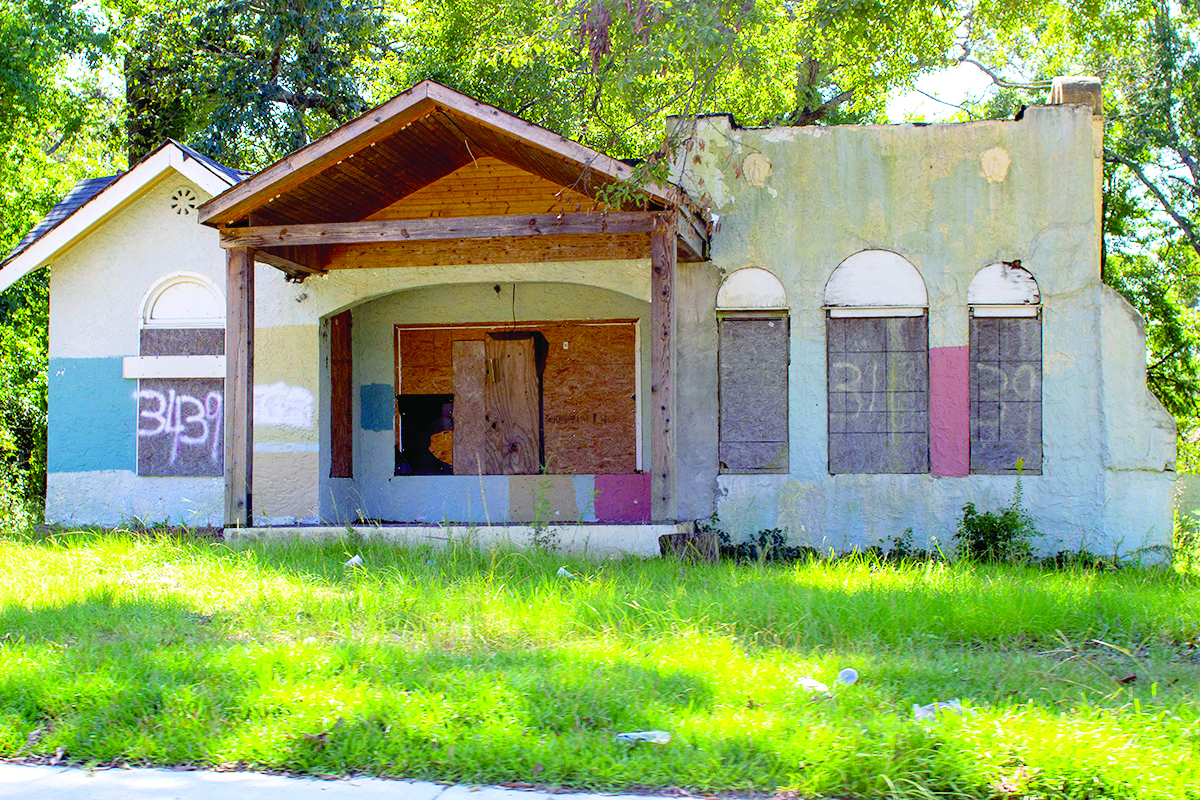
The West Jackson Capitol Street community used to be a white community until desegregation in schools caused a surge of white families to leave Jackson to surrounding cities. Many now-decayed houses were left behind. Photo by Acacia Clark
Today, the immediate environs of the struggling Jackson Zoo are dramatically decrepit due in no small part to the huge decaying buildings near the zoo. Some of them were mega-churches back when the area was solidly white, but are now old and mostly abandoned structures. What were probably thriving businesses in the area’s heyday are now boarded up and empty. Many houses throughout the community are blighted and buried in vines and trees.
In just recent months, streets littered with potholes, dramatic even by Jackson’s current street conditions, are finally seeing reconstruction and paving, including the once-grand thoroughfare of West Capitol, which passes by the zoo and its home inside Livingston Park.
After crossing under what is now Interstate 220, West Capitol becomes Clinton Boulevard as it winds past the lush Mynelle Gardens Arboretum and the turn-off to the site of old racist Council School 6 Magnolia. It also passes the once-pristine Lakewood Memorial Park where infamous white supremacists like former Gov. James K. Vardaman, Citizens Council leader William J. Simmons, anti-integration attorney John Satterfield and deceased segregationist Hederman newspaper scions – all of whom pushed racist rhetoric and segregation that exacerbated white violence against white citizens – are buried amid the results and debris of their divisive, racist efforts to keep Black people from overcoming intentional inequities.
The Works Progress Administration built many of the zoo’s buildings, including the Castle and the Monkey House, during the Great Depression just over a decade after the zoo opened on what was then the western outskirts of Jackson. The zoo was technically for everyone regardless of race, but the reality was different.

The Works Progress Administration built many of the zoo’s buildings, including the Castle on Monkey Island, during the Great Depression just over a decade after the zoo opened in 1919 in majority-white and prosperous West Jackson. Then came integration and the resulting white flight. File photo by Kristin Brenemen
In 1962, Black Jackson residents Rev. L. A. Clark, Mary A. Cox and W. R. Wren sued white Mayor Allen Thompson, Police Chief W. D. Rayfield, Parks and Recreation Director George Kurts, Commissioners Dock Luckey and Tom Marshall, Circuit Judge and City Library Chairman Leon Hendrick and more of the capital city’s all-white leadership for denying them “the right to use the public parks, libraries, zoos, golf courses, playgrounds, auditoriums and other public recreational facilities of the City.”
City leadership, the lawsuit said, discriminated through de facto segregation or, as the court put it when denying the Black plaintiffs an injunction, because the defendants “encourage voluntary separation of the races.” It also challenged three state laws set up in the 1950s to enforce segregation in Mississippi, with one of them demanding that all state governments prohibit compliance with U.S. Supreme Court integration decisions.
A United Press International story on the front page of the Hedermans’ then stridently segregationist Clarion-Ledger said of the lawsuit: “It charges city officials with depriving Negroes of their constitutional rights. Negroes, (the lawsuit) said, ‘have been and are now being greatly harmed, damaged and injured by the unlawful and wrongful acts of defendants.” Reporter Cliff Sessions’ story did not include interviews with any Black people.
The courts, while skeptical of the Black plaintiffs, ultimately ruled that Jackson had to integrate its recreational facilities, including the zoo. In response, Mayor Thompson ordered all of Jackson’s public pools and toilets closed and the removal of picnic tables and benches from public parks and facilities, including the Jackson Zoo.
The zoo, of course, would decline in popularity in years and decades after this lawsuit and after white flight from the area accelerated. Ultimately, it was school integration that dramatically altered the once-thriving Jackson community around the zoo with more than 11,000 white families pulling white children out of area public schools and enrolling them in white segregation academies, including the nearby Council 6 Magnolia school, after the U.S. Supreme Court forced school integration in early 1970 in a case brought by Holmes County mother Beatrice Alexander. Fifty-two years after that court decision, Pecan Park Elementary School, just blocks from the Jackson Zoo, is overwhelmingly Black with a sprinkling of Latino children.
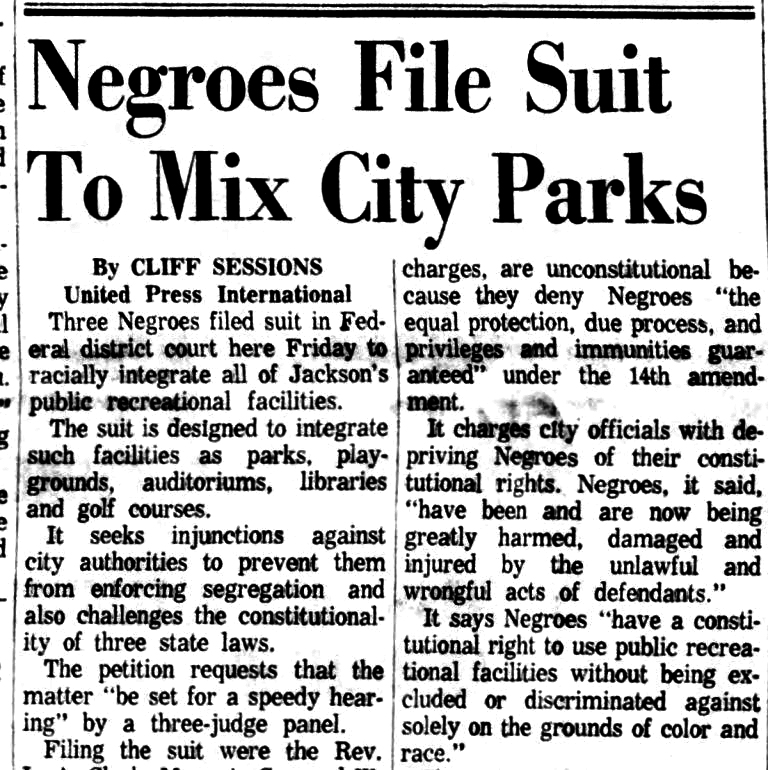
This 1962 Clarion-Ledger article reported on a lawsuit that three Black Jackson residents filed against the City of Jackson against policies and practices of segregation in all public recreational facilities in the capital city, from public libraries to parks to the Jackson Zoo. Clipping: Clarion-Ledger via newspapers.com
Alongside the white flight, the neighborhood started a dramatic descent in property values ultimately leaving the abandoned, crumbling buildings that surround the Jackson Zoo today, as well as the park’s challenges getting families to visit.
Violence is also a challenge for local families. The West Capitol Street community resides in Jackson’s Ward 3, which saw 34 murders in 2021, second behind Ward 5.
The zoo itself has become a lightning rod of controversy as most white metro residents will not come back to the area for a few hours of watching tigers and bears, with many of the donors most able to fund revitalization of the zoo refusing to unless it follows white-flight patterns to the eastern part of the city toward majority-white Rankin County. Bring it to us, and we’ll help fund it, the logic goes. But we’re not going back over there.
But to Shaneika Green, West Jackson is home. And it’s getting more violent since the pandemic hit. When she moved to the area in 2019, she didn’t have any complaints of crime or violence occurring. But once COVID-19 hit, she saw notable changes in the neighborhood.
“It’s like as soon as Covid hit that’s when you start hearing the gunshots and the shootings,” Green told the Mississippi Free Press.
History of Repeated White Violence in Jackson, Hinds
Gunshots, shootings, hangings, beatings, knife attacks. Many Mississippians, especially white folks, love to trumpet the good old days, supposedly, the capital city had a “crime problem.” But Hinds County’s inception with enslaved and brutalized Black people ripped apart from their families and working area plantations, Jackson and other communities in Hinds County have been riddled with race violence and murders. In fact, Hinds has long been Mississippi’s hotbed of race violence and terrorism – at the hands of white people.
As if the moniker of being the county with the most documented lynchings (22) in a state where murders and massacres of Black people was commonplace since the state’s inception isn’t bad enough, the history of white terrorism is even worse and more commonplace than that number represents.
Black men were long the hunted across Mississippi, especially when they tried to work to better themselves and their families, but it was even worse in and around the state capital and its halls of white power. This was especially true during Reconstruction when for a few years until white violence shut it down in the 1875 election Black people and white supporters – then Republicans – had the political upper hand.
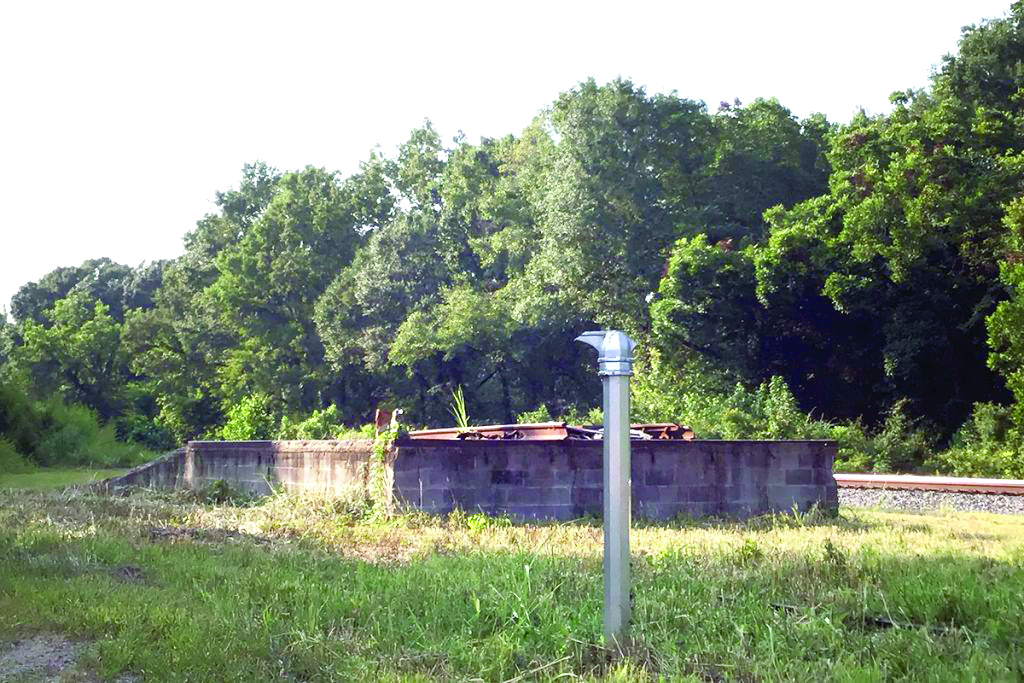
The Clinton Massacre of 1875 at the Moss Hill plantation, sometimes referred to as Moses Hill, was an attack by former Confederates and white sympathizers at a rally of Black Republican and white supporters in Hinds County. Starting at the rally and over upcoming weeks, white vigilante groups from inside and outside the county killed up to 50 Black residents, including Charles Caldwell, Mississippi’s first Black senator, in the first large and violent white insurrection that would end Reconstruction and electoral and other rights Black southerners briefly enjoyed. The massacre went largely unrecognized for 140 years until the city commemorated the bloodshed with a historical marker. A railroad worker apparently knocked down the sign from the post pictured here, and the city has not yet erected a new sign. Photo by Donna Ladd
In response, nearly 100 years before the 1960s party switch on race, the “First Mississippi Plan” made its opening salvo in the Clinton Massacre of 1875 to stop Black people and white supporters from voting and holding office. White former Confederates, and many of their children and grandchildren, used violence to stop the rise of multi-racial Republican power, reverse Black gains during Reconstruction and, in 1890 (called the Second Mississippi Plan), to instill James Z. George’s Jim Crow laws to subjugate and hamstring Black Mississippians into the 1890 Constitution where they stopped Black advancement until civil-rights legislation finally ended overturned the racist laws in the 1960s after decades of generational inequity passed forward.
Throughout this time and deep into the 20th century, Hinds County was both the center of power in the state and, thus, the site of Black men being shot, beaten, chased, hung, terrorized and “wantonly butchered” both for trying to register to vote or another leg-up effort, or sometimes just for walking down the street as an angry Klansman or other racist white men passed, as Michael Newton detailed in instance after instance of Hinds County violence in his “The Ku Klux Klan in Mississippi: A History,” as did the U.S. House on Un-American Activities in the 1960s. The terrorists were confident they wouldn’t be prosecuted no matter how heinous because the jurors (and racist journalists and editors) looked and usually thought like they did. They were still trying to preserve the way of life Confederates tried to extend indefinitely in the South and any new states.
Continual terrorism to keep Black Hinds Countians subjugated “in their place” continued long past passage of J. Z. George’s 1890 Jim Crow laws. The second wave of the Ku Klu Klan, this time very strong among educated northerners, returned to Mississippi in the 1920s.
“Jackson’s knights delayed their first public appearance until 4 July 1922,” Newman wrote in his KKK book. “That night, an estimated 450 to 600 Klansmen bearing fiery crosses marched four abreast along Capitol Street, from the old statehouse to Union Station. The racists carried signs reading “America for Americans,” “Separation of Church and State,” “Sanctity of the Home” and “We Stand for Free Speech, Free Schools, Free Press.”
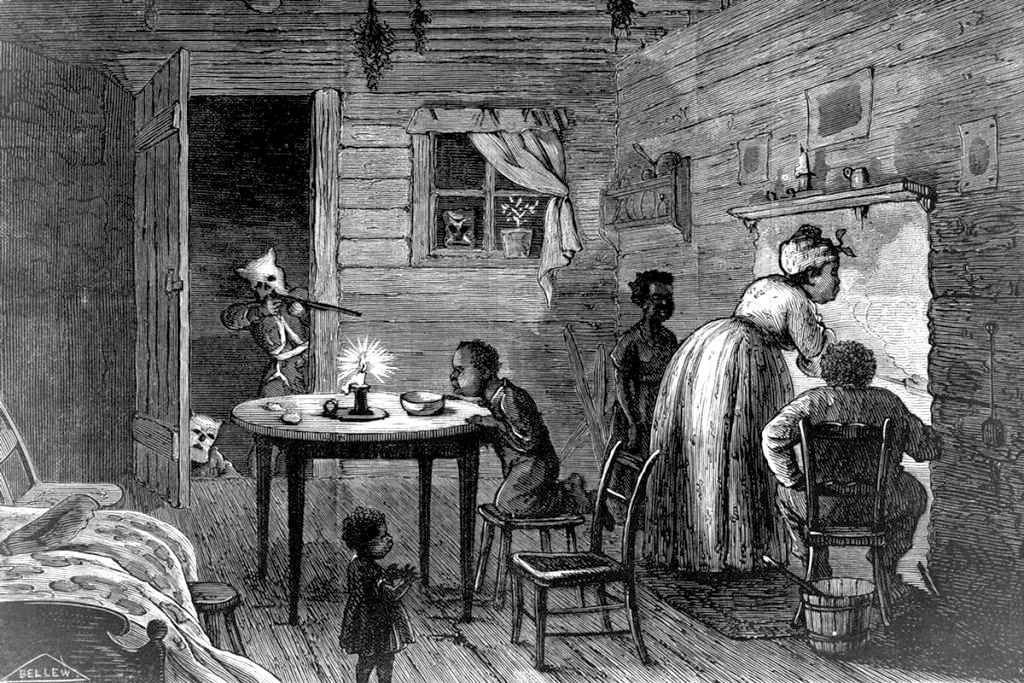
Starting in the late 1860s, white terrorists of the Ku Klux Klan and other white vigilante groups in Mississippi like the Red Shirts, White Caps and White League chapters were the enforcers against any gains of wealth and electoral power of Black citizens, demanding censorship of teaching facts about the Confederacy and white violence even as they brutalized and often killed Black and white teachers, Black political candidates and white supporters, and random Black people on the street in Hinds County, which had the most lynchings in Mississippi. They also threatened Black people away from the polls in 1875 and then ended Reconstruction and rolled back Black gains. The KKK revived in the 1920s, marching on Capitol Street in Jackson, and then again in the 1960s to fight school and public integration, leading a reign of terror, lynchings and bombings across Hinds County and Mississippi. “Visit of the Ku-Klux” by Frank Bellew/Library of Congress
Part III
Jackson Clarion-Ledger reporters, still as openly racist as they were in the 19th century and would be for more than half of the 20th century, expressed awe at the “stately cadence of the march,” calling it “an impressive spectacle,” Newman wrote.
By the 1960s, of course, the 1954 Brown desegregation decision and efforts to desegregate public facilities such as the zoo and parks, had white Jacksonians in every income bracket up in arms, often literally, and particularly about the “invasion” of civil-rights volunteers from outside the state, many of them white, who banded with local Black people to stand up against Jim Crow and race violence and to bring national attention to it.
The movement had to take on arguably the most powerful racist group in the country in the uptown, educated, sophisticated Mississippians and imports who ran the Citizens Councils of America from the heart of downtown Jackson, using lies and rhetoric to stoke white resistance and violence. Even as white students were punching, kicking and dumping condiments on the heads of a multiracial group of activists at the downtown Jackson Woolworth lunch corner in 1963; shooting white Rev. Ed King in the face in 1963 and Ku Klux Klan and Citizens Council member Byron de la Beckwith executing NAACP leader Medgar Evers in front of his wife and children in the Elraine subdivision in Jackson also in 1963, the Citizens Council constantly pushed the white-man’s myth that Black people were born violent and were a threat to white people.
Therefore, they needed to stay in lesser-funded schools on their own, continue to be redlined out of wealthier neighborhoods and blocked from the same opportunities as Citizen Councilors and their children. In fact, William J. “Bill” Simmons’ The Citizen newspaper ran scare story after cherry-picked scare story of Black people committing crime and violence across the U.S. even as most violence victims, then and now, are hurt or killed by people of their own race.
White violence did not end in Jackson when the Civil Rights Movement came to a close; after the King Edward (formerly the site of large Klan meetings) closed to avoid integrating; and white families pulled their children out of newly integrated public schools in droves.
On April 12, 1996, white supremacist and Vietnam veteran Larry Shoemake, the son of a World War II veteran who lived in his late parents’ home next to once-whites-only Wingfield High School when South Jackson was still more mixed-race than today, set up at the Po’ Folks restaurant outside the Ellis Isle Shopping Center just off Interstate 20 (today the site of the New Horizon Church). There the sniper with Mein Kampf and other Nazi materials back at his parents’ home used his Russian-made AR-15 to start firing at Black people out shopping. He terrorized them for 40 minutes, killing D.Q. Holifield and his son Johnny from Forest, Miss., in what a letter at home promised would be a race war on people who were supposedly inferior to him.
At a motel across the interstate from Ellis Isle, a group of white teenagers from Brandon in Rankin County found James Craig Anderson when they were out in by-then-majority-Black Jackson looking for a Black man to harass. They ran over him multiple times with a pickup truck for no other reason than the color of his skin. They had already committed a variety of assaults when they came to the capital city on night rides hunted down, as they put it, “n—ers,” to harass just as white men had done in the area for well over a century since Emancipation.
That is only a smattering of examples, but be clear: Jackson and Hinds County, that is, have always been a violent place for Black people with systemic barriers that have kept it that way, while increasing violence inside communities riddled with poverty and with limited opportunity.
‘Vicious Cycle of Poverty and Crime’
When the COVID-19 pandemic hit in March 2020, Jackson was already in a precarious state. The city’s infrastructure had crumbled for years as potholes and sinkholes, big enough to fit orange traffic cones and sometimes people in, littered the streets. In 2019, the capital city was in the midst of a lawsuit against Siemens Inc. over faulty water meters across Jackson households in 2014. The botched effort cost local taxpayers millions even as residents received expensive water bills or none at all, leading to people on fixed incomes owing so much that they cannot pay it back.
Due to old water pipes, many residents went without water for nearly a month after an icestorm froze the pipes back in February 2021. Food deserts in large sections of Jackson have left some communities food-insecure due to a lack of grocery stores or healthy food options. And many young people say that basic hunger, among related problems, often leads to crime inside the city limits.
The poverty rate for Black people in Jackson is 27.8%, and the unemployment poverty rate for Black women 49.2%. And, in 2021, employed Black women were only making 63% of what non-Hispanic white men were paid.
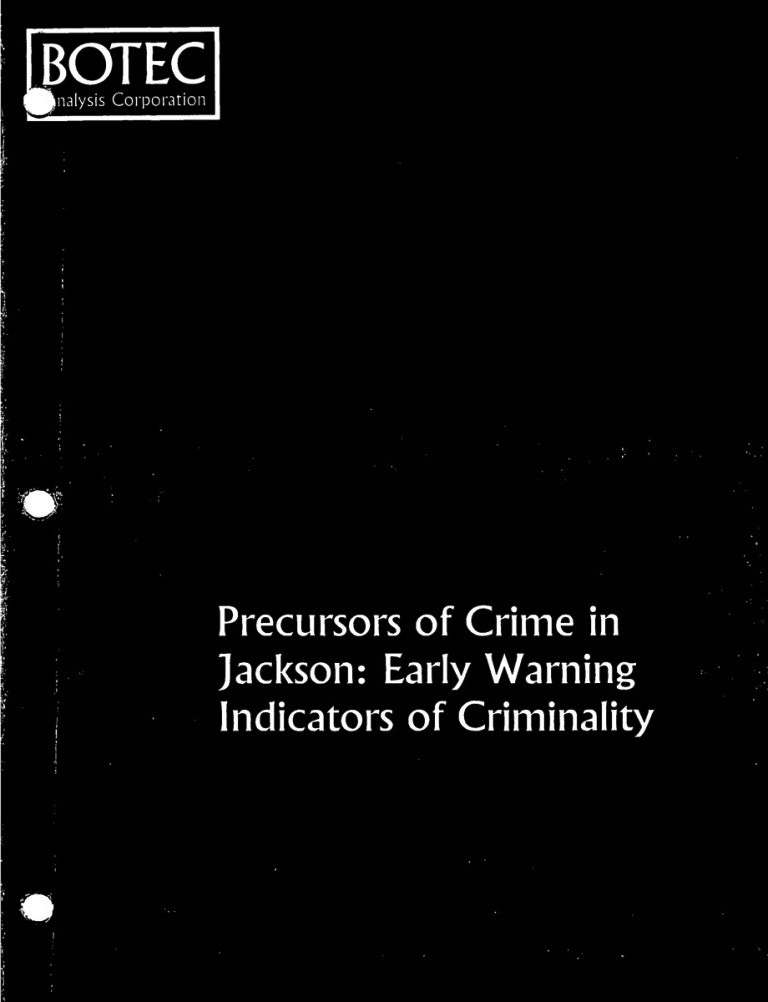
A little-reported 2016 BOTEC Analysis study of Jackson crime, which the Mississippi approved and funded, found that a small population of young people are at high risk of committing violence due to precursors like dropping out of school and negative interactions with police as minors. It advised prevention solutions beyond policing.
In 2016, in a bipartisan effort, the State of Mississippi released a series of BOTEC Analysis reports on Jackson crime, which the Legislature funded and then-Attorney General Jim Hood arranged. The reports, researched on the ground in Jackson by crime-prevention specialists across the country, were a deep dive into the causes of violence in the capital city with a look at violence prevention beyond hiring more police or locking up more people. The BOTEC Precursors of Crime report on Jackson explains that poverty is linked to crime, but in complex ways. Economic challenges contribute to crime and delinquency, which results in the disproportionate incarceration of Black men.
BOTEC’s “Precursors of Crime in Jackson: Early Warning Indicators of Criminality” reported that through interviews with inmates and ex-offenders, the researchers learned that poverty was the main motivation for why these individuals turned to crime. Factors such as low-wage jobs, lack of youth programs, lack of access to mental-health facilities, neighborhood blight and transportation were linked to crime in Jackson.
Young people who live in disadvantaged neighborhoods have an increased risk for delinquent behaviors. Indicators of future criminality include involvement in the juvenile justice system, chronic absenteeism, dropping out of school or failing a grade, the report read. A significant precursor was being placed in the back of a police car as a minor, which is common.
“Economic problems at the family level increase self-reported delinquency, drug use and parental reports of aggressive behavior,” the report states.
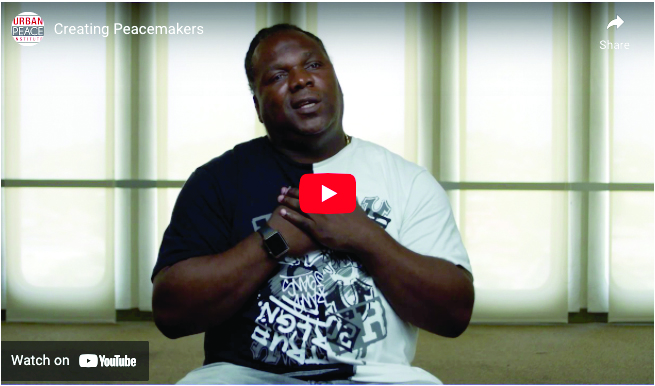
BOTEC researchers studied the causes of Jackson, Miss., crime in 2016 and reported that a small percentage of the city’s young people would become violent criminals. It advised that young people likely to turnt o crime were easy to predict due to precursors like dropping out of school and police interactions as minors. It recommended efforts such as the Urban Peace Institute in Los Angeles to reduce the likelihood of young people turning to violence. Courtesy Urban Peace Institute
BOTEC researchers predicted in the 2016 report that between 10% to 12% of students who attended Wingfield High School, Lanier High School, Provine High School and Jim Hill School would end up in the adult criminal-justice system. Without targeted interventions, between 4% and 8% of students who attended Murrah High School, Callaway High School and Forest Hill High School would be likely to enter the adult criminal justice system due to the poverty rates and precursors present in those communities and populations as of 2016, BOTEC researchers warned.
The reports argued then that those students were identifiable due to the precursors (such as drop-outs, previous interaction with police) and recommended evidence-based interventions that could redirect them, specifically detailing the Urban Peace Institute in Los Angeles, for instance, as a model for an organized and sustained anti-violence effort.
The Poverty-Crime Connection
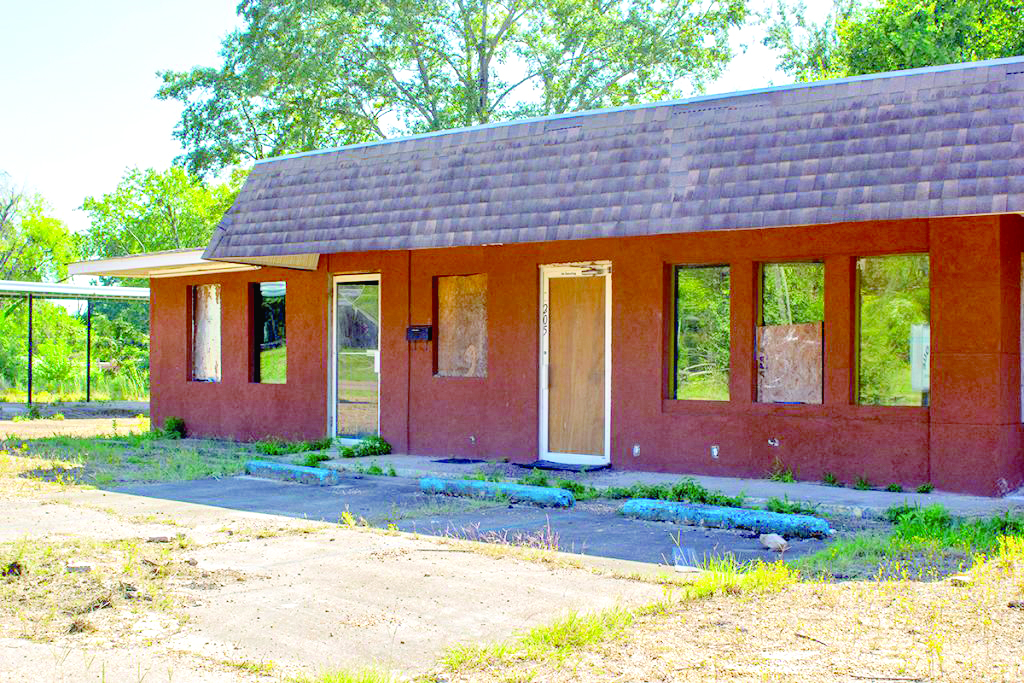
Many businesses off West Capitol Street have been boarded up, and one of the only businesses that is still open is a liquor store. Photo by Acacia Clark
BOTEC researchers interviewed both currently and formerly incarcerated Jacksonians who spoke of how poverty pushed them to turn to illegal activities. Many voiced their frustrations with having to choose between low-wage jobs and public benefits. Public assistance is usually not available to working people and the minimum wage, $7.25 an hour, isn’t enough to support a family.
“The lowest-paid workers in Jackson spend at least half of their paycheck on housing,” the 2016 BOTEC Analysis report states.
The median household income in the capital city is $38,888. In Jackson today, income poverty for Black residents rests at around 34%, while it is less than 15% for white residents. Liquid-asset poverty among Black people in Jackson sits at 64% and around 25% for white people.
There is a 65% difference in median home value between Black and white homeowners in Mississippi. And while white businesses are valued at more than $1,000,000, Black businesses are barely reaching $100,000.
Neighborhood blight also factors into crime as abandoned houses, often called bandos, shelter runaway youth and provide a haven for drug use or gang activity – and the State of Mississippi owns many of the crumbling properties in Jackson. One of the inmates BOTEC researchers interviewed spoke of the many foreclosures he saw in his neighborhood and how the people who lived in those houses couldn’t afford to stay, but no one wanted to move in.
Young People Lacking Opportunities, Services
Researchers emphasized that a lack of youth programs and opportunities in Jackson, especially for the young people who need them the most, cause young people to be bored – in a stark contrast to white suburbs that ring the city. Opportunities for young people also follow white and economic flight. One woman who was incarcerated at the county jail spoke to BOTEC about the many recreational programs for youth disappearing and, for many, the programs that remain weren’t affordable. Plus, many youth programs do not accept young people seen as potential troublemakers, thus prolonging the cycle.
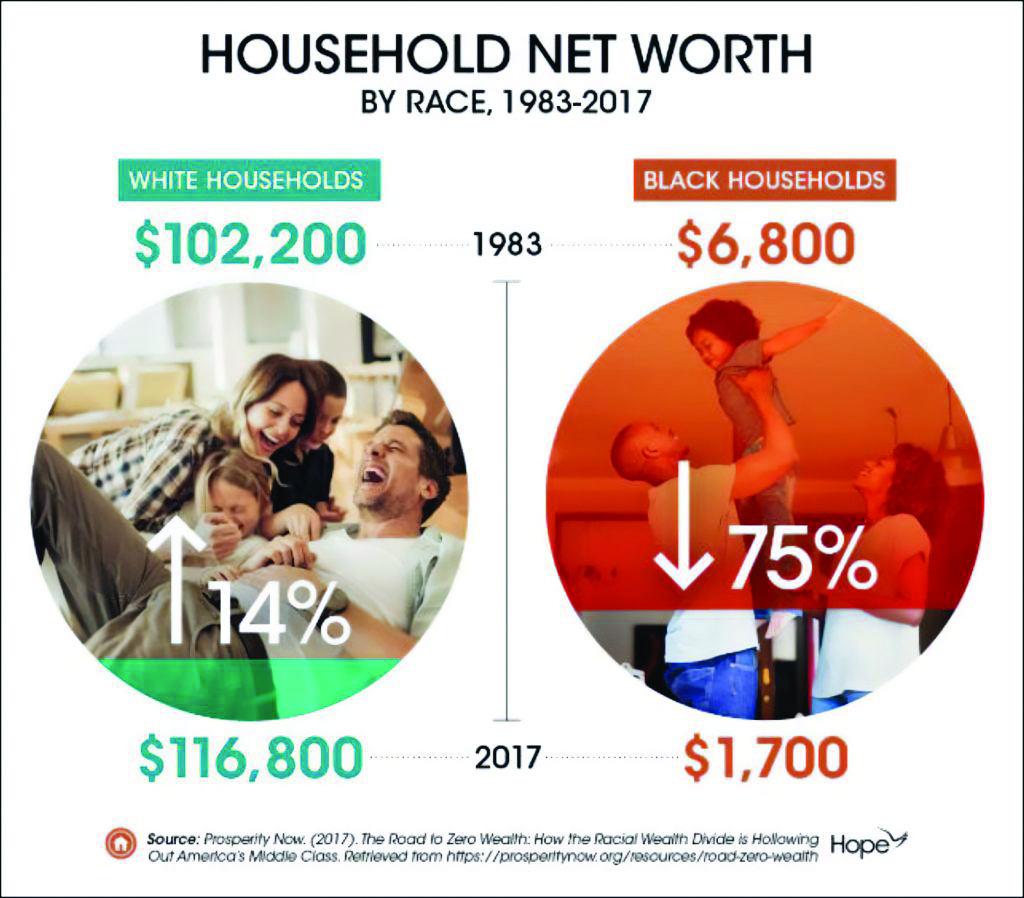
Black households in the nation held a net worth of $6,800 overall in 1983 compared to white households, who held a net worth of $102,200 in that same year. Courtesy Hope Policy Institute
Many young people living in heavily policed areas get in trouble due to mental health problems – often landing in the back of a police car as a minor. BOTEC researchers identified such police interaction of minors as one of the top precursors, alongside dropping out of school, for committing worse crime later.
“Participants in the study who lived in poverty mentioned that they or their family members needed mental health treatment, but failed to receive it,” the BOTEC study states. “Many felt that they or their loved ones had been misdiagnosed.”
In addition, police are often called out to deal with people in the midst of mental-health crises – and are not trained to respond well, too often leading to brutality and even death of someone needing help.
Often without reliable cars in a driving culture, residents in the poorest parts of the city have trouble commuting to work outside their neighborhoods – which often have few jobs available – in a metro without reliable public transportation. The JATRAN bus system has 12 routes, is known for being unreliable, and some areas are underserved.
“Bus service ends at 7:30 p.m, eliminating public transportation as an option for individuals working evening or night shifts,” the report reads.
Shaneika Green pointed to the transportation system as an issue that needs addressing. Transportation is key to combating poverty, so that residents in the poorest parts of town have a way to get to work, BOTEC reported. Jackson only has two real modes of transportation: car or the JATRAN.
Plus, even walking to work or schools can be treacherous in neighborhoods left to crumble into poverty, becoming havens for criminal activity. To get back and forth to youth activities, extracurricular activities and part-time jobs, young people often need rides in households where reliable adult transportation to and from work is scarce, or with mothers working multiple jobs with no time to chauffeur their kids around as happens in more affluent communities.
“Clinton (Miss.) doesn’t have public transportation, so how are they going to get to work? They don’t have transportation. They can’t carpool with anybody. They don’t want to give the people that live here an opportunity. They want to take it outside of Jackson,” Green said.
‘Not A Lot of Disposable Income’
Fifty years ago, Jackson was a crucial transportation hub. The Illinois Central Railroad, which runs through West Capitol Street, transported items in and out of the city and throughout the country, as Angela Stewart explained it. Hawkins Field, near the zoo, was the city’s first airport and solidly inside the city’s limits instead of where it sits now: east of the city in a carved-out extension of Jackson surrounded by Rankin County and its white businessmen and developers eager to take over the economic potential of the property.
Even back in more segregated times, businesses in Jackson provided sources of income for the working class and people who didn’t have college degrees.
“You could work at places like Vickers. You could work at places like Frito-Lay. You could work at places like the mills, up and down your street, you could work on the railroad,” Stewart said. “They provided places where people could make a good living, and they didn’t have to worry about trying to get outside the city limits of Jackson to get a job.”
Part IV
Jackson is home to a number of different industries that range from leisure and hospitality to mining and logging. Government jobs; trade, transportation and utilities; and education and health services are the top three industries in the city. The average weekly wages for all industries in Hinds County amounts to $982, which has large swathes of poor communities beyond its affluent white towns and developments.
From 1995 until today, there has been a steady decline in jobs across the information; manufacturing; construction; financial activities; and mining and logging industries. There are less than 25,000 employees in each of these sectors with one industry pulling in less than 1,000 employees.
Today, Jackson’s few job opportunities are finding people of all races leaving the city for surrounding counties like Madison and Rankin to find well-paying jobs. And with poor public transportation, especially across county lines, that can be challenging for Jackson residents without a car.
“What is also hard on Jackson is you don’t have an income base for people so that they can make money and pay property taxes. So, you have a larger renter base, people who are paying the rent, but they’re not paying property taxes,” Stewart said.
The Hope Policy Institute’s “Race & The Economy in Jackson, MS” reports that in 1983, white families held eight times more family wealth than Black families. As time went by, white families continued to accrue family wealth while Black families remained stagnant in building wealth. In 2016, median family wealth for white families was $171,000, 10 times more than Black families who accrued $17,409 by that same year.
Those inequities were baked in throughout Jackson’s overtly racist history.
Racialized Economic Exploitation
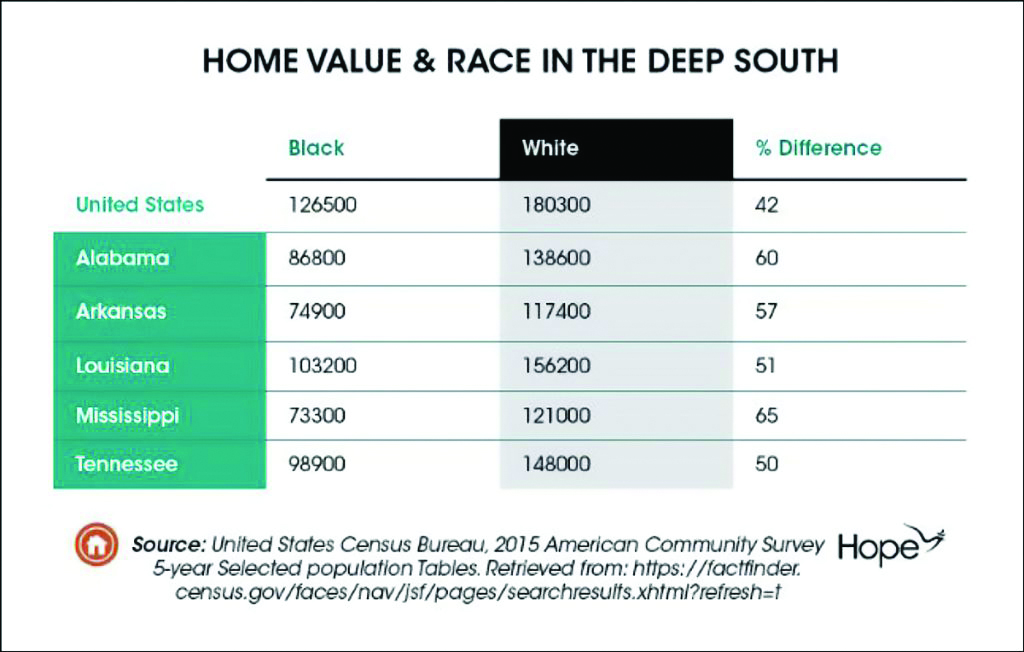
There is a 65% difference between the value of Black and white home value in Mississippi. After the Supreme Court ordered school integration in 1970, many white people fled neighborhoods like South and West Jackson with home values dropping as neighborhoods became Blacker. Courtesy Hope Policy Institute
Mississippi’s economy was originally built on racialized economic exploitation through chattel slavery, convict leasing and eventually sharecropping. These practices didn’t stop after the passage of the Emancipation Proclamation, freeing Black people from slavery if not systemic discrimination, and continued into the mid-20th century embedded into place by the Jim Crow provisions in the 1890 Mississippi Constitution designed to help keep Black residents marginalized and powerless.
The white-supremacist exploitation was designed to block Black economic and political progress for generations forward. It wasn’t a secret – everyone from Klansmen to successful white newspaper publishers and editors said it out loud.
But Jackson, and much of Mississippi and the U.S., were not allowed to turn the corner on that inequity even after the Civil Rights Movement ended Jim Crow laws. The immediate massive white flight from cities like Jackson led to disinvestment in schools and businesses. Resulting drops in home values and property taxes and ongoing racist practices like redlining to keep neighborhoods segregated amped up right as Black Jacksonians got a legal shot at equality and a chance for wealth generation. The law may have changed, but the discrimination and inequity-building continued.
Between 2004 and 2008, 30% of loans to Black households finished foreclosure in 2012 or were at imminent risk, compared to 12% for white households in Mississippi. These foreclosures totaled $352 million in lost wealth for communities of color in the state. Black homeownership has failed to recover since the recession and has continued to decline. In 2019, Black homeownership rates were at 51%, their lowest point in 14 years.
As recently as 2016, Tupelo, Miss.-based BancorpSouth was fined $10.6 million for using redlining and discriminatory lending to hurt Black people in Memphis, just 209 miles north of Jackson. A 2018 National Community Reinvestment Coalition study found that Black communities and families hamstrung by redlining back in the 1930s are still affected by it today. The report shows that neighborhoods branded in red ink as “hazardous” on Federal Home Owners’ Loan Corp. maps from 1935 to 1939 are still much more likely to have lower-income residents of color.
“It’s as if some of these places have been trapped in the past, locking neighborhoods into concentrated poverty,” Jason Richardson, director of research at the NCRC, told The Washington Post.
The web of economic disparities and practices feed off each other, resulting in far more than a zoo without enough visitors or economic support, even as it is a potent symbol of the train of disparities that hit Shaneika Green’s neighborhood starting with integration.
“They don’t have a lot of disposable income to do a lot of shopping, so it’s hard to keep businesses open if people don’t have the money. When people don’t have money, crime goes up,” Stewart explained.
Angela Stewart of the Margaret Walker Center said today’s crime is connected to Jackson’s long-time disparities and the public narrative, which tends to look at symptoms rather than causes.
“Jackson is a place where the population has been shrinking and shrinking over the years, and you also have to deal with the negative publicity surrounding Jackson,” Stewart said. “ … Everybody’s got a quip about why people shouldn’t live in Jackson.”
When people leave cities, the money goes with it as cities lose tax dollars. And to recover from this downward spiral, some cities have had to raise taxes, trim municipal budgets or cut government funding. Once services start declining, residents with the means to do so move away, and those residents are often white residents but are also residents of color following the flight for better-funded schools and safer neighborhoods.
It doesn’t help that the white people who fled often disparage what they left behind, blaming the people and children who can’t afford to move, and even working to limit and control remaining resources. Or even refusing to fund a zoo because white people do not want to go back to a “Black” part of a city they left because it integrated.
White flight had a deep impact on areas like South Jackson, where Tramaine Green died on the side of the road, and where white and tax-base flight in the 1990s transitioned the area from wealthy residents and white-collar workers to more working-class people moving into the area. What is left behind from the disinvestment is a city that seems to be a shell of its former self, one that doesn’t resemble the Jackson of my childhood.
And the capital city continues to shrink.
The 2020 census showed Jackson with 153,701 residents, a 12% decrease from 173,514 in the 2010 census, which also means a lower tax base. Jackson, however, has made gains in the number of Black citizens that have moved to the city.
In 2011, Jackson was 79% Black, and by 2019, it reached 82%. White people have been leaving the city over the past decade, going from 20% in 2011 to 17% in 2019. Many Jacksonians in the 20-29 age group are migrating to surrounding counties like Madison and Rankin – if they stay in Mississippi.
COVID-19 Mixed Into the Stew of Inequity
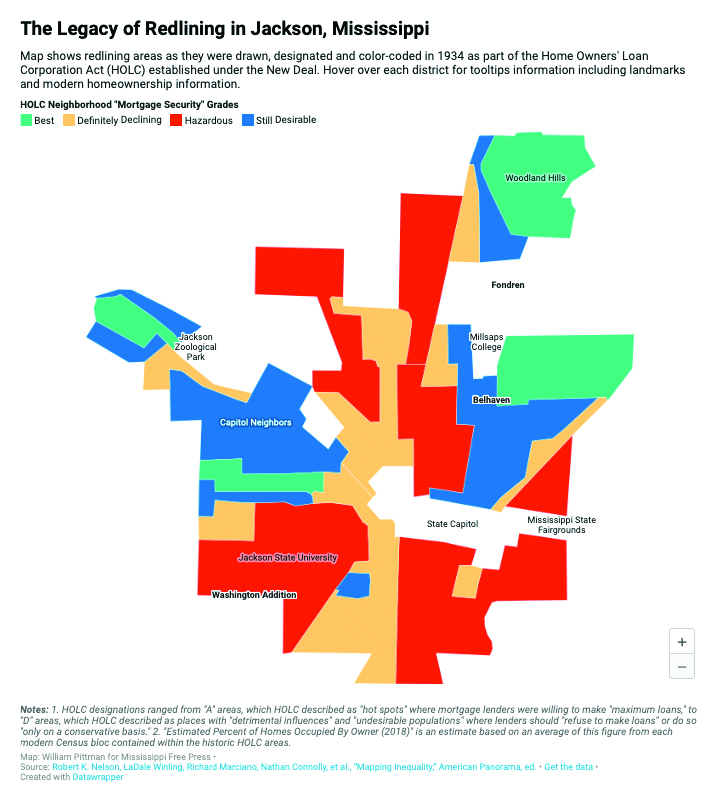
Notes: 1. HOLC designations ranged from “A” areas, which HOLC described as “hot spots” where mortgage lenders were willing to make “maximum loans,” to “D” areas, which HOLC described as places with “detrimental influences” and “undesirable populations” where lenders should “refuse to make loans” or do so “only on a conservative basis.” 2. “Estimated Percent of Homes Occupied By Owner (2018)” is an estimate based on an average of this figure from each modern Census bloc contained within the historic HOLC areas.
The pandemic reared its head in March 2020, quickly eliminating jobs, income and in-person learning, while leading to evictions and exacerbating other pre-existing issues, raising stress levels and challenging mental health. For an increasing number of people, crime and violence became an outlet some residents chose –for a plethora of reasons.
But systemic poverty is the big one that other inequities feed into and keep in place. It is a difficult cycle to break and about far more than willingness to work.
Shaneika Green worked at Walmart where she started as a customer host before switching to work as a cosmetic cashier. Working there provided her with a decent, livable wage, if she got enough hours. She worked there for three years before quitting in July 2021.
It was approaching the one-year anniversary of her son’s death, and Green knew she wouldn’t be in the right state of mind to work. She admits she didn’t have any time saved up to take off, but she asked her supervisor anyway. Her boss’ lack of sympathy about her grief rubbed Green the wrong way, and she left.
The married mother of six now works at an assembly line at Milwaukee Tool. The pay is about the same as what she made at Walmart at $11.36 an hour; the only difference is she gets paid every week, she said. She also prefers the anonymity that comes with working at the warehouse versus working at Walmart.
“At Walmart, everybody knows me. At the warehouse, it’s different areas, so really no one knows me or what I’ve been through. I don’t have to worry about anybody feeling sorry for me,” Green said.
The average hourly salary for a Walmart cashier can range from as low as $10.10 to $16.59 across the country. Mississippi ranks 30th out of 50 states for Walmart cashier job salaries.
Women in Mississippi are economic drivers for their families and the economy, but the state’s laws, public policies, workplaces and schools put barriers to the ways women and girls can succeed, Mississippi Black Women’s Roundtable reports.
“Black women working full-time, year-round in Mississippi are typically paid just 56 cents for every dollar paid to white non-Hispanic men. . . Black women in Mississippi typically have to earn a professional degree beyond a bachelor’s degree to make slightly more than white, non-Hispanic men with an associate’s degree,” the report states.
Mississippi Black Women’s Roundtable reports that the state has the highest poverty rate in the country for women overall, 20% compared to 12%, nationally. The poverty rate for Black women in Mississippi is three times the rate for white women and families headed by single mothers face the worst poverty rate in the state and one of the highest in the country.
‘How Are We Supposed to Feel?
Mayor Chokwe A. Lumumba says that the heightened violence in the city is a combination of many factors, not just one. But Jackson isn’t a unique case as most cities across the nation are experiencing an increase in homicides that surpasses the previous year’s numbers, he said.
Donna Ladd contributed to this story, including history of white terrorism in Jackson and Hinds County.
Correction: The original version of the above story contained an editing error. Travaine Green died in 2020, not 2021. The story is corrected.
This in-depth Hinds County historic report is part of the “(In)Equity and Resilience, Black Women, Systemic Barriers and COVID-19” project looking at systemic inequities long facing Mississippi’s Black women and their families and institutions that the pandemic revealed and exacerbated in Mississippi. In upcoming weeks and months, the BWC Project team is publishing what their systemic reporting and numerous solution circles with Black women revealed about three counties (so far): Noxubee (education); Hinds (violence and public safety) and Holmes (health care adequacy and access). The journalists are following up each county overview with specific solutions-journalisms pieces about problems their reporting revealed.
This project is a collaboration between the Mississippi Free Press and the Jackson Advocate with support from the Solutions Journalism Network.
Register at mfp.ms/circles to join a solutions circle to discuss violence prevention in Hinds County and beyond on Feb. 15, 2022 and write solutions@mississippifreepress.org to offer feedback on the reporting. Reach out to Kimberly Griffin at kimberly@mississippifreepress.org if you’d like to sponsor work in additional counties for this project.

